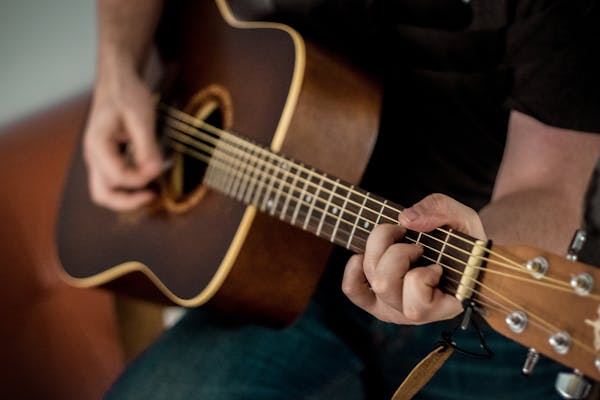Lofi guitar chord progressions shape the genre’s warm, nostalgic atmosphere. Choosing the right chords adds emotional depth and unique character to your beats. This guide highlights three inspiring progressions that blend simplicity with jazzy richness—perfect for producers seeking to elevate their sound with mellow, soulful vibes that define classic lofi music.
Essential lofi guitar chord progressions for relaxed, nostalgic beats
For an authentic lofi sound, exploring a Lofi chord progression built on mellow, jazzy, or soulful chords sets the perfect emotional tone. Chord sequences like Bmaj7 – C♯min7 – G♯min7 (in G♯ minor) and F♯min7 – G♯min7 – A6sus2 – C♯min7 (C♯ minor key) favor lush seventh extensions, making them easy to play and highly expressive. These beginner-friendly shapes fit naturally under the fingers, enabling relaxed, smooth transitions for a chilled-out vibe.
Also to read : Transforming clean transportation: groundbreaking innovations fueling zero-emission commercial vehicles across the uk
Minor and seventh chords provide warmth and emotional depth, especially when combined with simple picking or gentle strumming. A classic jazzy option, the Em9 – A13 – Dmaj9 – D6/9 progression in D major, highlights how soft chord voicings and subtle rhythmic nuances create inviting, nostalgic atmospheres. This approach layers harmonic richness without complexity, supporting both looping and improvisation in lofi settings.
To craft your own relaxed or ambient tracks, try using downloadable tabs or chord diagrams and experiment with rhythmic patterns to personalize each progression. For aspiring producers, tools like Zen Master offer preset sequences and a generator, making it painless to build evocative lofi chord beds.
Additional reading : Unlock 3 creative lofi guitar chord patterns to boost your tracks
The anatomy of lofi guitar chord progressions
Key features of the lofi guitar sound: imperfection, warmth, and softness
Precision: Lofi guitar chord progressions rely on imperfection and warmth. Genuine lofi character is achieved not by flawless execution but by the subtle flaws—slight string buzz, gentle fret noise, muted notes—that add human presence and nostalgic charm. To capture these, favor lighter touch, velvet-padded strumming, or relaxed fingerpicking. Incorporating natural background sounds, such as room ambience or vinyl crackle, deepens that mellow, worn-in quality essential to chill lofi guitar tracks.
Role of major, minor, and extended chords in shaping lofi’s emotional palette
Elaboration: Minor and seventh chords for lofi guitar tend to dominate, rooted in their emotional expressiveness. Minor chords set a reflective or melancholic atmosphere, while major chords offer gentle brightness. Extended chords—7ths, 9ths, and 11ths—create layers of complexity, giving even simple chord sequences a softer, jazz-inspired edge. This balance invites both introspection and optimism, characteristic of relaxed lofi beats.
Why jazz, 7th, and 9th chords enhance the lofi guitar mood
Chill guitar progressions for lofi music often draw directly from classic jazz. Jazz-influenced progressions, especially those using 7th and 9th chords, add richness and subtle tension that resolve smoothly, fostering a dreamy, tranquil vibe. Using softer guitar voicings and muted strums further supports the immersive, relaxing spirit of ambient lofi guitar music.
Three inspiring lofi guitar chord progressions explained
G♯ minor: Bmaj7 – C♯min7 – G♯min7 for dreamy fingerpicked lines
Precision: This progression consists of three chords—Bmaj7, C♯min7, G♯min7—each sharing melodic tones that produce a dreamy, nostalgic lofi sound.
Recall: The gently fingerpicked lines highlight relaxed movement and emotive voicings, with all chords suited for mellow, slow-tempo guitar progressions.
Starting in G♯ minor, this sequence uses simple chord shapes and a fingerpicking pattern, providing a signature lofi guitar sound. The use of 7th chords adds subtle complexity without overwhelming the listener. Emphasizing the G♯ minor pentatonic scale when soloing helps maintain the chill, airy vibe that’s so effective in lofi music.
C♯ minor: F♯min7 – G♯min7 – A6sus2 – C♯min7 for jazzy and neo-soul chillhop
This progression brings a jazzy, neo-soul feel with easy chord transitions. Employing a swung rhythm, these voicings invoke both warmth and modern sophistication. Muting and barre techniques support smoother changes, and the A6sus2 chord opens up colorful harmonies ideal for ambient guitar layers. This is especially beginner-friendly for those aiming to craft relaxed, yet dynamic, lofi beats.
D major: Em9 – A13 – Dmaj9 – D6/9 for groovy, jazzy 2-5-1 flavor
The D major progression stands out for its groovy movement and lush jazz harmony. Using extended chords like Em9 and A13 provides harmonic depth. A strum-picking groove with palm muting delivers a soft, percussive texture—perfect for slow, meditative lofi moods. Experimenting with slides and hammer-ons enhances atmosphere without sacrificing simplicity.
Enhancing your lofi progressions: tips, techniques, and customization
Creative picking patterns instantly set a dreamy mood in lofi. Use fingerpicking or gentle arpeggios—starting simply, then introduce patterns that accent offbeats or emphasize the melody. Palm muting softens attack and adds percussive warmth. Lightly rest your picking hand’s edge near the bridge for subtler chords, enhancing that intimate, vintage feel.
Experiment with chord voicing variations; swap standard shapes for extended or inverted forms to keep things fresh. Inversions allow smoother, flowing transitions, avoiding abrupt jumps between shapes and maintaining a mellow atmosphere.
Applying effects like reverb, delay, and gentle distortion shapes the lofi soundscape. A touch of reverb adds dimension and nostalgia, while a short delay thickens the progression. Subtle overdrive or tape-style distortion recreates the fuzzy warmth of classic recordings, enhancing emotional depth.
Layering is essential for rich, relaxed textures. Record a basic chord loop, then add harmonics, muted strums, or even sampled background noise (like vinyl crackle) for extra authenticity. Experiment with rhythm: try syncopation, swing, or quiet pauses to build interest and make each progression unique.
Looping techniques let you test how progressions evolve and interact with melodic lines, offering endless possibilities for personalization and emotional resonance.











